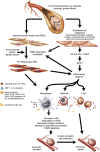Biology of intracranial aneurysms: role of inflammation
- PMID: 22781330
- PMCID: PMC3434628
- DOI: 10.1038/jcbfm.2012.84
Biology of intracranial aneurysms: role of inflammation
Abstract
Intracranial aneurysms (IAs) linger as a potentially devastating clinical problem. Despite intense investigation, our understanding of the mechanisms leading to aneurysm development, progression and rupture remain incompletely defined. An accumulating body of evidence implicates inflammation as a critical contributor to aneurysm pathogenesis. Intracranial aneurysm formation and progression appear to result from endothelial dysfunction, a mounting inflammatory response, and vascular smooth muscle cell phenotypic modulation producing a pro-inflammatory phenotype. A later final common pathway appears to involve apoptosis of cellular constituents of the vessel wall. These changes result in degradation of the integrity of the vascular wall leading to aneurysmal dilation, progression and eventual rupture in certain aneurysms. Various aspects of the inflammatory response have been investigated as contributors to IA pathogenesis including leukocytes, complement, immunoglobulins, cytokines, and other humoral mediators. Furthermore, gene expression profiling of IA compared with control arteries has prominently featured differential expression of genes involved with immune response/inflammation. Preliminary data suggest that therapies targeting the inflammatory response may have efficacy in the future treatment of IA. Further investigation, however, is necessary to elucidate the precise role of inflammation in IA pathogenesis, which can be exploited to improve the prognosis of patients harboring IA.
Figures


Similar articles
-
Flow-induced, inflammation-mediated arterial wall remodeling in the formation and progression of intracranial aneurysms.Neurosurg Focus. 2019 Jul 1;47(1):E21. doi: 10.3171/2019.5.FOCUS19234. Neurosurg Focus. 2019. PMID: 31261126 Free PMC article. Review.
-
TNF-alpha-mediated inflammation in cerebral aneurysms: a potential link to growth and rupture.Vasc Health Risk Manag. 2008;4(4):805-17. doi: 10.2147/vhrm.s2700. Vasc Health Risk Manag. 2008. PMID: 19065997 Free PMC article. Review.
-
Gene expression profiles in human ruptured and unruptured intracranial aneurysms: what is the role of inflammation?Stroke. 2010 Feb;41(2):224-31. doi: 10.1161/STROKEAHA.109.562009. Epub 2009 Dec 31. Stroke. 2010. PMID: 20044533
-
Nonsteroidal Anti-Inflammatory Drugs: A Potential Pharmacological Treatment for Intracranial Aneurysm.Cerebrovasc Dis Extra. 2019;9(1):31-45. doi: 10.1159/000499077. Epub 2019 Apr 30. Cerebrovasc Dis Extra. 2019. PMID: 31039577 Free PMC article. Review.
-
Smooth Muscle Peroxisome Proliferator-Activated Receptor γ Plays a Critical Role in Formation and Rupture of Cerebral Aneurysms in Mice In Vivo.Hypertension. 2015 Jul;66(1):211-20. doi: 10.1161/HYPERTENSIONAHA.115.05332. Epub 2015 Apr 27. Hypertension. 2015. PMID: 25916724 Free PMC article.
Cited by
-
Classification models using circulating neutrophil transcripts can detect unruptured intracranial aneurysm.J Transl Med. 2020 Oct 15;18(1):392. doi: 10.1186/s12967-020-02550-2. J Transl Med. 2020. PMID: 33059716 Free PMC article.
-
The Role of Gut and Oral Microbiota in the Formation and Rupture of Intracranial Aneurysms: A Literature Review.Int J Mol Sci. 2023 Dec 19;25(1):48. doi: 10.3390/ijms25010048. Int J Mol Sci. 2023. PMID: 38203219 Free PMC article. Review.
-
Development and validation of a predictive model for the prognosis in aneurysmal subarachnoid hemorrhage.J Clin Lab Anal. 2020 Dec;34(12):e23542. doi: 10.1002/jcla.23542. Epub 2020 Aug 29. J Clin Lab Anal. 2020. PMID: 32860455 Free PMC article.
-
Intracranial aneurysms in pediatric population: a two-center audit.Childs Nerv Syst. 2021 Aug;37(8):2567-2575. doi: 10.1007/s00381-021-05151-6. Epub 2021 Apr 20. Childs Nerv Syst. 2021. PMID: 33876302
-
Localized increase of chemokines in the lumen of human cerebral aneurysms.Stroke. 2013 Sep;44(9):2594-7. doi: 10.1161/STROKEAHA.113.002361. Epub 2013 Jul 25. Stroke. 2013. PMID: 23887838 Free PMC article.
References
-
- Ait-Oufella H, Taleb S, Mallat Z, Tedgui A. Recent advances on the role of cytokines in atherosclerosis. Arterioscler Thromb Vasc Biol. 2011;31:969–979. - PubMed
-
- Andersson J, Libby P, Hansson GK. Adaptive immunity and atherosclerosis. Clin Immunol. 2010;134:33–46. - PubMed
-
- Anto RJ, Mukhopadhyay A, Shishodia S, Gairola CG, Aggarwal BB. Cigarette smoke condensate activates nuclear transcription factor-kappaB through phosphorylation and degradation of IkappaB(alpha): correlation with induction of cyclooxygenase-2. Carcinogenesis. 2002;23:1511–1518. - PubMed
-
- Aoki T, Kataoka H, Ishibashi R, Nakagami H, Nozaki K, Morishita R, Hashimoto N.2009aPitavastatin suppresses formation and progression of cerebral aneurysms through inhibition of the nuclear factor kappaB pathway Neurosurgery 64357–365.discussion 365–6 - PubMed
Publication types
MeSH terms
Substances
Grants and funding
LinkOut - more resources
Full Text Sources
Other Literature Sources
Medical

